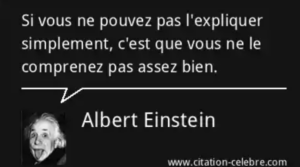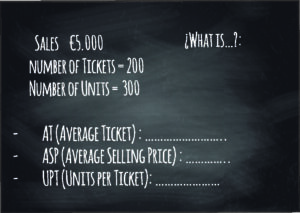
“I’M BAD AT MATHS !” HOW TO COACH AND ENGAGE EVEN THE ONE WHO STUDIED LITERATURE!
Based on our 15,000 individual coaching sessions at CapKelenn, we’ve observed that 35% of salespeople and 10% of their sales managers admit to feel unsecure or even totally lost with mathematics.
Of course, no one is going to ask in a weekly sales meeting, “Boss, can you explain how the conversion rate or the churn rate is calculated?”. But, in the intimacy of a professional, confidential individual coaching session (and we have delivered more than 10,000 over 13 years at CapKelenn, source of this statistic), these difficulties and frustrations emerge.
VERBATIM (listened in individual coaching sessions)
- Benoit, in fact I don’t understand actually, I don’t understand numbers; what I do and love is sell!
- I studied literature!
- You must have done Harvard or Oxford to understand The excel file we use to prepare the commercial proposal for customers, with all its links, its sheets and its formulas. As soon as I enter a price in a cell, I’m afraid to mess everything up.
- “Yesterday in training, when you spoke of a 3% growth what is “percent” exactly?
- When we say that the Sales Index (Units per Ticket) is 1.7, I know it means between 1 and 2, but what is 7 exactly?
So indeed, the concept of percentage or decimals, taught in elementary school, is far from clear to everyone.
HUMAN AND MANAGERIAL COST
Leaders are sometimes taken aback after this feedback on their teams:
- “I would never have imagined that my teams understand so little about numbers. Should I replace them? “.
- No, I don’t think so, but it is urgent to improve this dialogue of the deafs.
The feeling of vulnerability and insecurity surrounding the mastery of figures leads competent professionals to lose all their confidence, in front of the client, in front of their manager or in front of their colleagues in meeting, and sometimes to enter into an avoidance strategy.
In the era of omnichannel, CRM, ERP, how to ensure that these professionals who feel complexed with figures, KPIs, can feel safer?
8 SOLUTIONS
1 – Simple wording: Einstein said, “If you can’t explain it simply, you don’t understand it well enough.” Instead of hammering out business goals, managers could vary the wording. For example, instead of saying “this month, we absolutely have to improve conversion from 18% to 20%!”, the manager can say: “last month, out of 100 sales visits, we signed the order in 18 % of cases. It seems possible then to you to convert 2 more visits into deals and reach 20%!” This very visual language (2 converted visits out of 100) makes the challenge very tangible in the eyes of “non-mathematicians”!

2 – Cross-training: during a cycle 1 of a Retail Coaching Certification, in a well-known department stores, the trainer-coach, after asking the section managers to perform 3 “simple” calculations, asked the question: “From 0 to 10, how comfortable did you feel?” Out of 10 people, 4 answer “6 or less”. One of the participants answers 10 and spontaneously offers to make herself available in a room to teach her colleagues 2 days later, 1 hour before the opening. In cycle 2, we learnt that this internal session between colleagues was a massive success. The room literally filled up. Training between colleagues, without judgement (no risk to feel ashamed), can unlock misunderstandings, frustrations or complexes.

3 – The leader-coach style: based on questioning and silences, will allow the employee to verbalize, therefore to feel in control, empowered and thus the manager to ensure that the key figures are understood. Effective questions for example: What do you think of your results? Which KPI are you most proud of? How can you increase this KPI? …
4 – Slow down the verbal flow: if we pronounce on average 200 words per minute, an ambitious manager haranguing his teams may pronounce up to 300 words per minute. When we talk about numbers and KPIs, on the contrary, it is a question of slowing down, to avoid “losing” part of the audience.
5 – Digestible Excel projections: during meetings (presencial or via Zoom / Teams), it is better to limit the Excel projections to 3 columns and 4 rows (that already 12 data); whereas we often see files of 20 lines and 20 columns (400 data).
6 – Focus on key figure : so during a sales meeting, it is important for the leader to extract the priority key figure and put the focus on it, as Steve Jobs used to do.
7 – Revise the Dashboard: know how to summarize the main management indicators on one single A4 sheet. Here again, it is about the manager’s capacity to synthesize and to practice the leverage effect. (focus on factor that hace impact on final result)
8 – Use graphics and colors on the dashboard: This is the challenge of management control; to make information attractive. So if in the table the sell index appears in yellow, then in the chart, this indicator also appears in yellow. (“Ah, if we had such a clear dashboard!”). I have known too many talents held back in their careers by their Maths complex. And yet, it’s true, performance is expressed in numbers, in ratios. It is a language to learn; Numbers are the language of the bosses. We could analyze the causes and the background (school, limiting beliefs…), but the purpose of this article is different: To help managers who read this article, to open up a space for the development of their teams which allow even awareness and action on mathematical skills.
Nicolas Boileau said:
“Whatever is well conceived is clearly said, and the words to say it flow with ease.” Words, yes, and numbers, too.
CapKelenn in luxury retail
CapKelenn is the primary certification in Retail Coaching worldwide, certifying managers in Retail to really become coaches for their sales teams, facilitating the transition towards a supreme clienteling savoir-faire. CapKelenn delivers the certification in 12 languages on all the 5 continents. CapKelenn accelerates change, thanks to people, with results that are fast, visible and sustainable, contributing to fertilize a client experience that is memorable and personalized.
Benoit Mahé.



